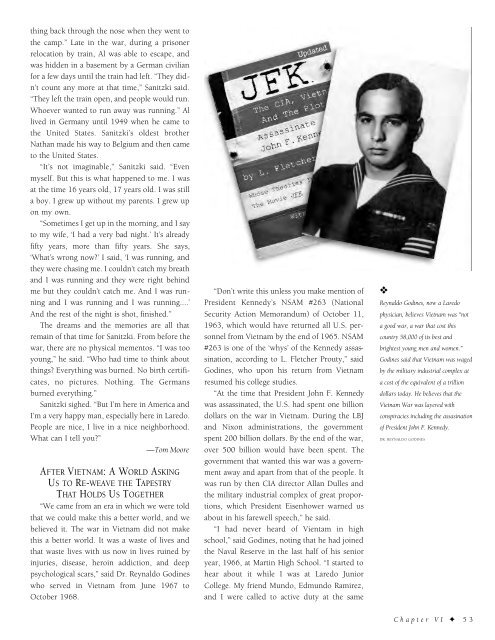Historic Laredo
An illustrated history of the city of Laredo and the Webb County area, paired with the histories of companies, families and organizations that make the region great.
An illustrated history of the city of Laredo and the Webb County area, paired with the histories of companies, families and organizations that make the region great.
You also want an ePaper? Increase the reach of your titles
YUMPU automatically turns print PDFs into web optimized ePapers that Google loves.
thing back through the nose when they went to<br />
the camp.” Late in the war, during a prisoner<br />
relocation by train, Al was able to escape, and<br />
was hidden in a basement by a German civilian<br />
for a few days until the train had left. “They didn’t<br />
count any more at that time,” Sanitzki said.<br />
“They left the train open, and people would run.<br />
Whoever wanted to run away was running.” Al<br />
lived in Germany until 1949 when he came to<br />
the United States. Sanitzki’s oldest brother<br />
Nathan made his way to Belgium and then came<br />
to the United States.<br />
“It’s not imaginable,” Sanitzki said. “Even<br />
myself. But this is what happened to me. I was<br />
at the time 16 years old, 17 years old. I was still<br />
a boy. I grew up without my parents. I grew up<br />
on my own.<br />
“Sometimes I get up in the morning, and I say<br />
to my wife, ‘I had a very bad night.’ It’s already<br />
fifty years, more than fifty years. She says,<br />
‘What’s wrong now?’ I said, ‘I was running, and<br />
they were chasing me. I couldn’t catch my breath<br />
and I was running and they were right behind<br />
me but they couldn’t catch me. And I was running<br />
and I was running and I was running....’<br />
And the rest of the night is shot, finished.”<br />
The dreams and the memories are all that<br />
remain of that time for Sanitzki. From before the<br />
war, there are no physical mementos. “I was too<br />
young,” he said. “Who had time to think about<br />
things? Everything was burned. No birth certificates,<br />
no pictures. Nothing. The Germans<br />
burned everything.”<br />
Sanitzki sighed. “But I’m here in America and<br />
I’m a very happy man, especially here in <strong>Laredo</strong>.<br />
People are nice, I live in a nice neighborhood.<br />
What can I tell you?”<br />
—Tom Moore<br />
AFTER VIETNAM: A WORLD ASKING<br />
US TO RE-WEAVE THE TAPESTRY<br />
THAT HOLDS US TOGETHER<br />
“We came from an era in which we were told<br />
that we could make this a better world, and we<br />
believed it. The war in Vietnam did not make<br />
this a better world. It was a waste of lives and<br />
that waste lives with us now in lives ruined by<br />
injuries, disease, heroin addiction, and deep<br />
psychological scars,” said Dr. Reynaldo Godines<br />
who served in Vietnam from June 1967 to<br />
October 1968.<br />
“Don’t write this unless you make mention of<br />
President Kennedy’s NSAM #263 (National<br />
Security Action Memorandum) of October 11,<br />
1963, which would have returned all U.S. personnel<br />
from Vietnam by the end of 1965. NSAM<br />
#263 is one of the ‘whys’ of the Kennedy assassination,<br />
according to L. Fletcher Prouty,” said<br />
Godines, who upon his return from Vietnam<br />
resumed his college studies.<br />
“At the time that President John F. Kennedy<br />
was assassinated, the U.S. had spent one billion<br />
dollars on the war in Vietnam. During the LBJ<br />
and Nixon administrations, the government<br />
spent 200 billion dollars. By the end of the war,<br />
over 500 billion would have been spent. The<br />
government that wanted this war was a government<br />
away and apart from that of the people. It<br />
was run by then CIA director Allan Dulles and<br />
the military industrial complex of great proportions,<br />
which President Eisenhower warned us<br />
about in his farewell speech,” he said.<br />
“I had never heard of Vientam in high<br />
school,” said Godines, noting that he had joined<br />
the Naval Reserve in the last half of his senior<br />
year, 1966, at Martin High School. “I started to<br />
hear about it while I was at <strong>Laredo</strong> Junior<br />
College. My friend Mundo, Edmundo Ramirez,<br />
and I were called to active duty at the same<br />
❖<br />
Reynaldo Godines, now a <strong>Laredo</strong><br />
physician, believes Vietnam was “not<br />
a good war, a war that cost this<br />
country 58,000 of its best and<br />
brightest young men and women.”<br />
Godines said that Vietnam was waged<br />
by the military industrial complex at<br />
a cost of the equivalent of a trillion<br />
dollars today. He believes that the<br />
Vietnam War was layered with<br />
conspiracies including the assasination<br />
of President John F. Kennedy.<br />
DR. REYNALDO GODINES<br />
Chapter VI ✦ 53
















